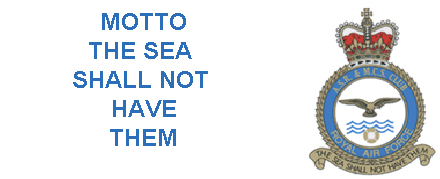RAF Air-Sea Rescue Museum

From 1918 to 1986 the Marine Branch of the Royal Air Force supplied
waterborne support, rescue facilities and services for the Royal Air Force
throughout the world.
Inaugurated as the Marine Craft Section just
eleven days after the Royal Air Force itself was founded, it
initially provided back-up for the flying boats but it also
developed a rescue service which during and after the second
world war became the largest in the world. During the war years
alone over 13,000 lives were saved by the crews of the high
speed rescue launches who faced enemy action and all weathers to
uphold their pledge of "The Sea Shall Not Have Them".
The launches were involved in many major actions; at
Dunkirk five seaplane tenders were deployed rescuing 500
troops from the beaches; at Dieppe 14 launches were in
action three of which were destroyed by enemy action and
93 launches were involved in the supporting maritime
landing operations on D Day. Launches also supported
operations in the Middle East, Malta and Italy and also
in the Far East, India, Burma, Malaya and Ceylon. The
launches also carried out clandestine operations in
Greece, Turkey and occupied Europe. Post-war, amongst
other duties, the branch was involved in secret
submarine location work, surveys and anti-terrorist
patrols. By 1986 the more versatile helicopter had taken
over the rescue work and finally the branch was
privatized its few remaining maritime activities being
taken over by civilian contractors.
Courtesy of Air Sea Rescue & Marine Craft
Section Club.
A Museum dedicated to Air Sea Rescue and Coastal Command was officially
opened on April 23rd 2000 at Flixton
Around the Air-Sea Rescue Museum
 Airborne
Lifeboat (ABL) MK1A – No. MVIII Airborne
Lifeboat (ABL) MK1A – No. MVIII
The history of this World War II, RAF Airborne Lifeboat MK1A
has been traced by the number on the stern post: MVIII. The
record card held by the RAF Museum identifies that it was built
under contract by Ranelagh Yacht Yard on the Isle of Wight and
later converted to a dinghy – Sailing Training - S/No 4097. The
brief unit history follows:
Thornaby, 84 Maintenance Unit (Repair), Calshot (1945),
Thorney Island (1946), 238 MU Mount Batten (1947), disposed of
(1948).
This type of lifeboat was carried beneath Warwick aircraft
and dropped at sea, attached to several parachutes, to ditched
aircrew – it would hold 7 men. Other marks of lifeboat followed;
these were larger in size and eventually had aluminium hulls.
The introduction of helicopters for Air-Sea Rescue operations
made them redundant.
This example is 23 feet 2 inches in length and was powered by
a pair of “Middy” engines. Construction was doubled skin
Mahogany on Rock Elm timbers, with plywood deck and watertight
bulkheads. The total weight carried by the aircraft, including
wire slings, parachutes, and parachute release equipment, was
1,700lbs.
The boat was fitted with automatically discharging rockets to
carry out a sea anchor, and floating lines by which survivors
could pull themselves into the boat. It was equipped with oars,
a mast and a sail, and lockers contained full engine, sailing
and navigation instructions printed on waterproof paper. It
would have been equipped with inflatable canopies over the bow
and stern (not present).
It was donated to the museum in april 2007 by a collector in
Ludham, Norfolk; following long-term external storage it arrived
in very poor condition. It is now displayed as near as possible
to its operational configuration in World War II - 1943 Onwards
– and deck components have been fabricated for completeness.
|


